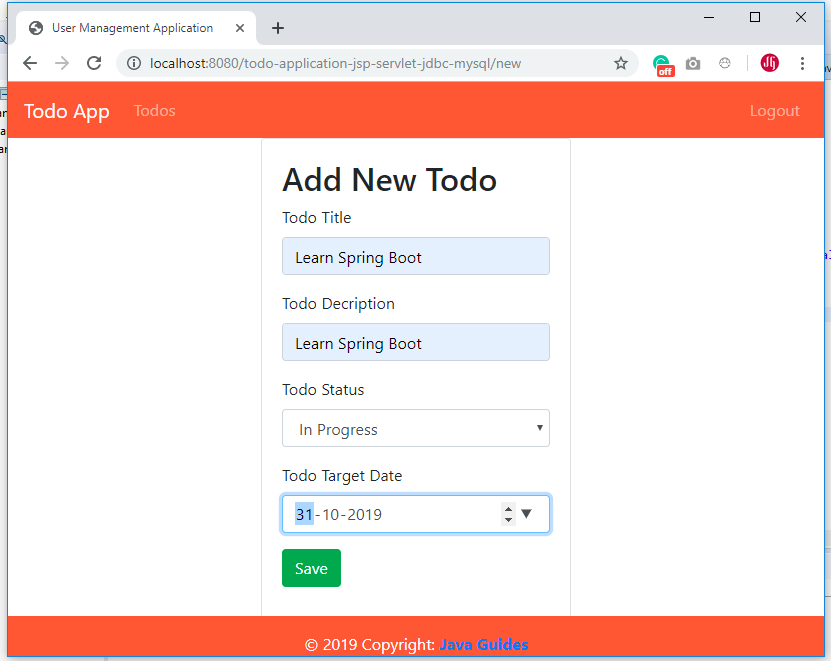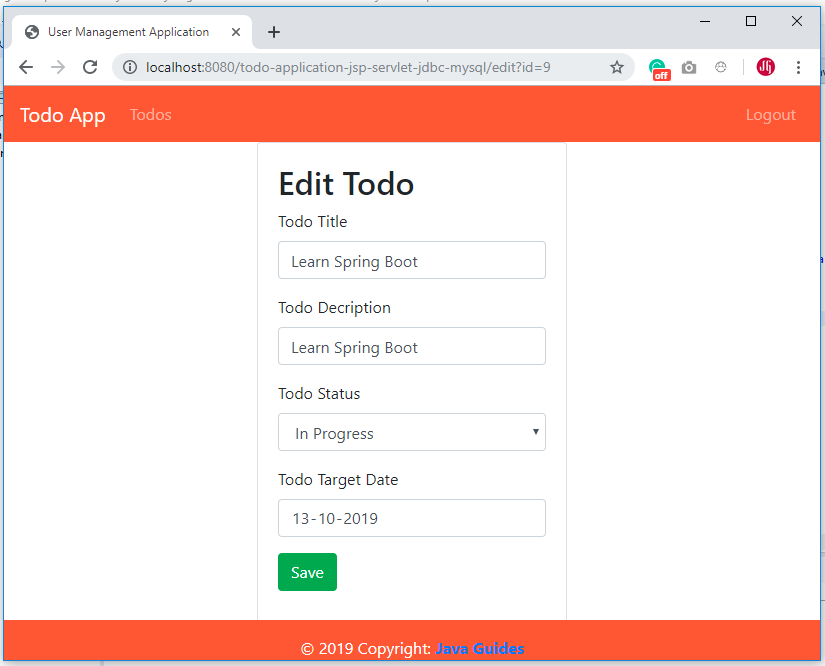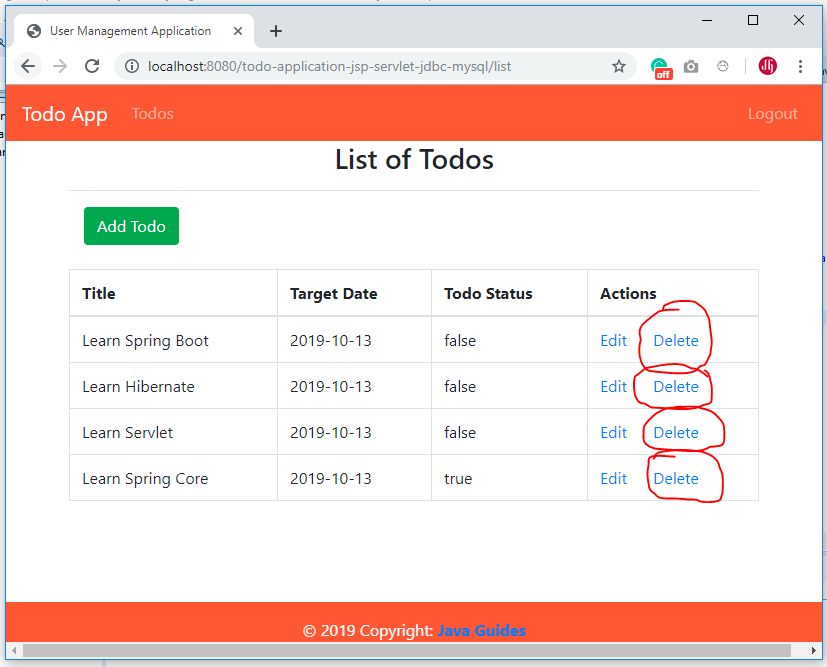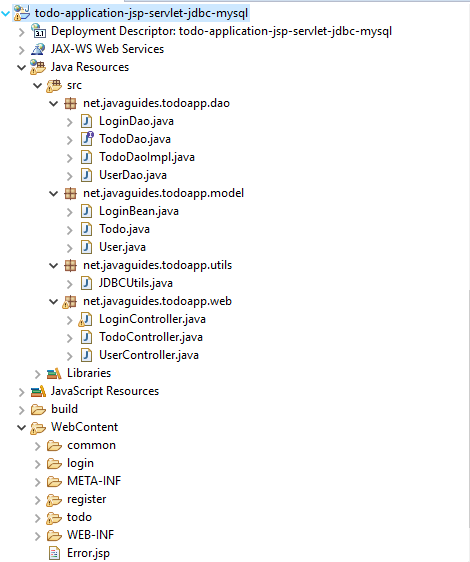🎓 Top 15 Udemy Courses (80-90% Discount): My Udemy Courses - Ramesh Fadatare — All my Udemy courses are real-time and project oriented courses.
▶️ Subscribe to My YouTube Channel (178K+ subscribers): Java Guides on YouTube
▶️ For AI, ChatGPT, Web, Tech, and Generative AI, subscribe to another channel: Ramesh Fadatare on YouTube
In this JSP Servlet tutorial, you will learn how to build a step-by-step Todo Management web application using JSP, Servlet, JDBC, and MySQL database.
Learn and master JSP at https://www.javaguides.net/p/jsp-tutorial.html.
Learn and master Servlet at https://www.javaguides.net/p/servlet-tutorial.html
Learn and master JDBC at https://www.javaguides.net/p/jdbc-tutorial.html
Learn and master Hibernate at https://www.javaguides.net/p/hibernate-tutorial.html
Tools and technologies used
- JSP - 2.2 +
- IDE - STS/Eclipse Neon.3
- JDK - 1.8 or later
- Apache Tomcat - 8.5
- JSTL - 1.2.1
- Servlet API - 2.5
- MySQL - mysql-connector-java-8.0.13.jar
Features Implementation
- Develop User registration module implementation
- Develop a Login module implementation
- Develop a Todo CRUD operations implementation
What we will build?
User Registration Page
Login Page
Add New Todo Page
Update Todo Page
List Todo Page
Delete Todo Page
MySQL Database Setup
CREATE TABLE `users` (
`id` int(3) NOT NULL AUTO_INCREMENT,,
`first_name` varchar(20) DEFAULT NULL,
`last_name` varchar(20) DEFAULT NULL,
`username` varchar(250) DEFAULT NULL,
`password` varchar(20) DEFAULT NULL,
PRIMARY KEY (`id`)
) ENGINE=InnoDB DEFAULT CHARSET=utf8mb4 COLLATE=utf8mb4_0900_ai_ci;
CREATE TABLE `todos` (
`id` bigint(20) NOT NULL AUTO_INCREMENT,
`description` varchar(255) DEFAULT NULL,
`is_done` bit(1) NOT NULL,
`target_date` datetime(6) DEFAULT NULL,
`username` varchar(255) DEFAULT NULL,
`title` varchar(255) DEFAULT NULL,
PRIMARY KEY (`id`)
) ENGINE=InnoDB AUTO_INCREMENT=8 DEFAULT CHARSET=utf8mb4 COLLATE=utf8mb4_0900_ai_ci;Create Dynamic Project in Eclipse
Project Structure
1. User Registration Module
1. Create a JavaBean - User.java
package net.javaguides.todoapp.model;
import java.io.Serializable;
/**
* JavaBean class used in jsp action tags.
* @author Ramesh Fadatare
*/
public class User implements Serializable {
private static final long serialVersionUID = 1 L;
private String firstName;
private String lastName;
private String username;
private String password;
public String getFirstName() {
return firstName;
}
public void setFirstName(String firstName) {
this.firstName = firstName;
}
public String getLastName() {
return lastName;
}
public void setLastName(String lastName) {
this.lastName = lastName;
}
public String getUsername() {
return username;
}
public void setUsername(String username) {
this.username = username;
}
public String getPassword() {
return password;
}
public void setPassword(String password) {
this.password = password;
}
}2. Configure JDBC Connection- JDBCUtils.java
package net.javaguides.todoapp.utils;
import java.sql.Connection;
import java.sql.Date;
import java.sql.DriverManager;
import java.sql.SQLException;
import java.time.LocalDate;
public class JDBCUtils {
private static String jdbcURL = "jdbc:mysql://localhost:3306/demo";
private static String jdbcUsername = "root";
private static String jdbcPassword = "root";
public static Connection getConnection() {
Connection connection = null;
try {
Class.forName("com.mysql.jdbc.Driver");
connection = DriverManager.getConnection(jdbcURL, jdbcUsername, jdbcPassword);
} catch (SQLException e) {
// TODO Auto-generated catch block
e.printStackTrace();
} catch (ClassNotFoundException e) {
// TODO Auto-generated catch block
e.printStackTrace();
}
return connection;
}
public static void printSQLException(SQLException ex) {
for (Throwable e: ex) {
if (e instanceof SQLException) {
e.printStackTrace(System.err);
System.err.println("SQLState: " + ((SQLException) e).getSQLState());
System.err.println("Error Code: " + ((SQLException) e).getErrorCode());
System.err.println("Message: " + e.getMessage());
Throwable t = ex.getCause();
while (t != null) {
System.out.println("Cause: " + t);
t = t.getCause();
}
}
}
}
public static Date getSQLDate(LocalDate date) {
return java.sql.Date.valueOf(date);
}
public static LocalDate getUtilDate(Date sqlDate) {
return sqlDate.toLocalDate();
}
}3. DAO Layer - UserDao.java
package net.javaguides.todoapp.dao;
import java.sql.Connection;
import java.sql.PreparedStatement;
import java.sql.SQLException;
import net.javaguides.todoapp.model.User;
import net.javaguides.todoapp.utils.JDBCUtils;
public class UserDao {
public int registerEmployee(User employee) throws ClassNotFoundException {
String INSERT_USERS_SQL = "INSERT INTO users" +
" (first_name, last_name, username, password) VALUES " +
" (?, ?, ?, ?);";
int result = 0;
try (Connection connection = JDBCUtils.getConnection();
// Step 2:Create a statement using connection object
PreparedStatement preparedStatement = connection.prepareStatement(INSERT_USERS_SQL)) {
preparedStatement.setString(1, employee.getFirstName());
preparedStatement.setString(2, employee.getLastName());
preparedStatement.setString(3, employee.getUsername());
preparedStatement.setString(4, employee.getPassword());
System.out.println(preparedStatement);
// Step 3: Execute the query or update query
result = preparedStatement.executeUpdate();
} catch (SQLException e) {
// process sql exception
JDBCUtils.printSQLException(e);
}
return result;
}
}4. Controller Layer - UserController.java
package net.javaguides.todoapp.web;
import java.io.IOException;
import javax.servlet.RequestDispatcher;
import javax.servlet.ServletException;
import javax.servlet.annotation.WebServlet;
import javax.servlet.http.HttpServlet;
import javax.servlet.http.HttpServletRequest;
import javax.servlet.http.HttpServletResponse;
import net.javaguides.todoapp.dao.UserDao;
import net.javaguides.todoapp.model.User;
/**
* @email Ramesh Fadatare
*/
@WebServlet("/register")
public class UserController extends HttpServlet {
private static final long serialVersionUID = 1 L;
private UserDao userDao;
public void init() {
userDao = new UserDao();
}
protected void doPost(HttpServletRequest request, HttpServletResponse response)
throws ServletException, IOException {
register(request, response);
}
protected void doGet(HttpServletRequest request, HttpServletResponse response)
throws ServletException, IOException {
response.sendRedirect("register/register.jsp");
}
private void register(HttpServletRequest request, HttpServletResponse response) throws IOException, ServletException {
String firstName = request.getParameter("firstName");
String lastName = request.getParameter("lastName");
String username = request.getParameter("username");
String password = request.getParameter("password");
User employee = new User();
employee.setFirstName(firstName);
employee.setLastName(lastName);
employee.setUsername(username);
employee.setPassword(password);
try {
int result = userDao.registerEmployee(employee);
if (result == 1) {
request.setAttribute("NOTIFICATION", "User Registered Successfully!");
}
} catch (Exception e) {
// TODO Auto-generated catch block
e.printStackTrace();
}
RequestDispatcher dispatcher = request.getRequestDispatcher("register/register.jsp");
dispatcher.forward(request, response);
}
}5. View Layer - register.jsp
header.jsp
<header>
<nav class="navbar navbar-expand-md navbar-dark"
style="background-color: tomato">
<div>
<a href="https://www.javaguides.net" class="navbar-brand"> Todo App</a>
</div>
<ul class="navbar-nav navbar-collapse justify-content-end">
<li><a href="<%= request.getContextPath() %>/login" class="nav-link">Login</a></li>
<li><a href="<%= request.getContextPath() %>/register" class="nav-link">Signup</a></li>
</ul>
</nav>
</header>footer.jsp
<style>
.footer {
position: fixed;
bottom: 0;
width:100%;
height: 40px;
background-color: tomato;
}
</style>
<footer class="footer font-small black">
<!-- Copyright -->
<div class="footer-copyright text-center py-3" style="color: white">© 2019 Copyright:
<a href="https://www.javaguides.net/" > <strong> Java Guides </strong></a>
</div>
</footer>
<!-- Footer -->register.jsp
- firstName
- lastName
- username
- password
<%@ page language="java" contentType="text/html; charset=ISO-8859-1"
pageEncoding="ISO-8859-1"%>
<!DOCTYPE html>
<html>
<head>
<meta charset="ISO-8859-1">
<title>Insert title here</title>
<link rel="stylesheet" href="https://stackpath.bootstrapcdn.com/bootstrap/4.3.1/css/bootstrap.min.css" integrity="sha384-ggOyR0iXCbMQv3Xipma34MD+dH/1fQ784/j6cY/iJTQUOhcWr7x9JvoRxT2MZw1T" crossorigin="anonymous">
</head>
</head>
<body>
<jsp:include page="../common/header.jsp"></jsp:include>
<div class="container">
<h2>User Register Form</h2>
<div class="col-md-6 col-md-offset-3">
<div class="alert alert-success center" role="alert">
<p>${NOTIFICATION}</p>
</div>
<form action="<%=request.getContextPath()%>/register" method="post">
<div class="form-group">
<label for="uname">First Name:</label> <input type="text" class="form-control" id="uname" placeholder="First Name" name="firstName" required>
</div>
<div class="form-group">
<label for="uname">Last Name:</label> <input type="text" class="form-control" id="uname" placeholder="last Name" name="lastName" required>
</div>
<div class="form-group">
<label for="uname">User Name:</label> <input type="text" class="form-control" id="username" placeholder="User Name" name="username" required>
</div>
<div class="form-group">
<label for="uname">Password:</label> <input type="password" class="form-control" id="password" placeholder="Password" name="password" required>
</div>
<button type="submit" class="btn btn-primary">Submit</button>
</form>
</div>
</div>
<jsp:include page="../common/footer.jsp"></jsp:include>
</body>
</html>2. Login Module
1. Create a JavaBean - LoginBean.java
package net.javaguides.todoapp.model;
import java.io.Serializable;
public class LoginBean implements Serializable {
private static final long serialVersionUID = 1 L;
private String username;
private String password;
public String getUsername() {
return username;
}
public void setUsername(String username) {
this.username = username;
}
public String getPassword() {
return password;
}
public void setPassword(String password) {
this.password = password;
}
}2. DAO Layer - LoginDao.java
package net.javaguides.todoapp.dao;
import java.sql.Connection;
import java.sql.PreparedStatement;
import java.sql.ResultSet;
import java.sql.SQLException;
import net.javaguides.todoapp.model.LoginBean;
import net.javaguides.todoapp.utils.JDBCUtils;
public class LoginDao {
public boolean validate(LoginBean loginBean) throws ClassNotFoundException {
boolean status = false;
Class.forName("com.mysql.jdbc.Driver");
try (Connection connection = JDBCUtils.getConnection();
// Step 2:Create a statement using connection object
PreparedStatement preparedStatement = connection
.prepareStatement("select * from users where username = ? and password = ? ")) {
preparedStatement.setString(1, loginBean.getUsername());
preparedStatement.setString(2, loginBean.getPassword());
System.out.println(preparedStatement);
ResultSet rs = preparedStatement.executeQuery();
status = rs.next();
} catch (SQLException e) {
// process sql exception
JDBCUtils.printSQLException(e);
}
return status;
}
}3. Controller Layer - LoginController.java
package net.javaguides.todoapp.web;
import java.io.IOException;
import javax.servlet.RequestDispatcher;
import javax.servlet.ServletException;
import javax.servlet.annotation.WebServlet;
import javax.servlet.http.HttpServlet;
import javax.servlet.http.HttpServletRequest;
import javax.servlet.http.HttpServletResponse;
import javax.servlet.http.HttpSession;
import net.javaguides.todoapp.dao.LoginDao;
import net.javaguides.todoapp.model.LoginBean;
/**
* @email Ramesh Fadatare
*/
@WebServlet("/login")
public class LoginController extends HttpServlet {
private static final long serialVersionUID = 1 L;
private LoginDao loginDao;
public void init() {
loginDao = new LoginDao();
}
protected void doGet(HttpServletRequest request, HttpServletResponse response)
throws ServletException, IOException {
response.sendRedirect("login/login.jsp");
}
protected void doPost(HttpServletRequest request, HttpServletResponse response)
throws ServletException, IOException {
authenticate(request, response);
}
private void authenticate(HttpServletRequest request, HttpServletResponse response) throws IOException, ServletException {
String username = request.getParameter("username");
String password = request.getParameter("password");
LoginBean loginBean = new LoginBean();
loginBean.setUsername(username);
loginBean.setPassword(password);
try {
if (loginDao.validate(loginBean)) {
RequestDispatcher dispatcher = request.getRequestDispatcher("todo/todo-list.jsp");
dispatcher.forward(request, response);
} else {
HttpSession session = request.getSession();
// session.setAttribute("user", username);
// response.sendRedirect("login.jsp");
}
} catch (ClassNotFoundException e) {
e.printStackTrace();
}
}
}4. View Layer - login.jsp
- username
- password
<%@ page language="java" contentType="text/html; charset=ISO-8859-1"
pageEncoding="ISO-8859-1"%>
<!DOCTYPE html>
<html>
<head>
<meta charset="ISO-8859-1">
<title>Insert title here</title>
<link rel="stylesheet" href="https://stackpath.bootstrapcdn.com/bootstrap/4.3.1/css/bootstrap.min.css" integrity="sha384-ggOyR0iXCbMQv3Xipma34MD+dH/1fQ784/j6cY/iJTQUOhcWr7x9JvoRxT2MZw1T" crossorigin="anonymous">
</head>
<body>
<jsp:include page="../common/header.jsp"></jsp:include>
<div class="container col-md-8 col-md-offset-3" style="overflow: auto">
<h1>Login Form</h1>
<form action="<%=request.getContextPath()%>/login" method="post">
<div class="form-group">
<label for="uname">User Name:</label> <input type="text" class="form-control" id="username" placeholder="User Name" name="username" required>
</div>
<div class="form-group">
<label for="uname">Password:</label> <input type="password" class="form-control" id="password" placeholder="Password" name="password" required>
</div>
<button type="submit" class="btn btn-primary">Submit</button>
</form>
</div>
<jsp:include page="../common/footer.jsp"></jsp:include>
</body>
</html>3. CRUD Operations
1. Model Layer - Todo.java
package net.javaguides.todoapp.model;
import java.time.LocalDate;
/**
* Todo.java
* This is a model class represents a Todo entity
* @author Ramesh Fadatare
*
*/
public class Todo {
private Long id;
private String title;
private String username;
private String description;
private LocalDate targetDate;
private boolean status;
protected Todo() {
}
public Todo(long id, String title, String username, String description, LocalDate targetDate, boolean isDone) {
super();
this.id = id;
this.title = title;
this.username = username;
this.description = description;
this.targetDate = targetDate;
this.status = isDone;
}
public Todo(String title, String username, String description, LocalDate targetDate, boolean isDone) {
super();
this.title = title;
this.username = username;
this.description = description;
this.targetDate = targetDate;
this.status = isDone;
}
public Long getId() {
return id;
}
public void setId(Long id) {
this.id = id;
}
public String getTitle() {
return title;
}
public void setTitle(String title) {
this.title = title;
}
public String getUsername() {
return username;
}
public void setUsername(String username) {
this.username = username;
}
public String getDescription() {
return description;
}
public void setDescription(String description) {
this.description = description;
}
public LocalDate getTargetDate() {
return targetDate;
}
public void setTargetDate(LocalDate targetDate) {
this.targetDate = targetDate;
}
public boolean getStatus() {
return status;
}
public void setStatus(boolean status) {
this.status = status;
}
@Override
public int hashCode() {
final int prime = 31;
int result = 1;
result = prime * result + (int)(id ^ (id >>> 32));
return result;
}
@Override
public boolean equals(Object obj) {
if (this == obj)
return true;
if (obj == null)
return false;
if (getClass() != obj.getClass())
return false;
Todo other = (Todo) obj;
if (id != other.id)
return false;
return true;
}
}DAO Layer - TodoDao.java and TodoDaoImpl.java
TodoDao.java
package net.javaguides.todoapp.dao;
import java.sql.SQLException;
import java.util.List;
import net.javaguides.todoapp.model.Todo;
public interface TodoDao {
void insertTodo(Todo todo) throws SQLException;
Todo selectTodo(long todoId);
List<Todo> selectAllTodos();
boolean deleteTodo(int id) throws SQLException;
boolean updateTodo(Todo todo) throws SQLException;
}TodoDaoImpl.java
package net.javaguides.todoapp.dao;
import java.sql.Connection;
import java.sql.PreparedStatement;
import java.sql.ResultSet;
import java.sql.SQLException;
import java.time.LocalDate;
import java.util.ArrayList;
import java.util.List;
import net.javaguides.todoapp.model.Todo;
import net.javaguides.todoapp.utils.JDBCUtils;
/**
* This DAO class provides CRUD database operations for the table todos in the
* database.
*
* @author Ramesh Fadatare
*
*/
public class TodoDaoImpl implements TodoDao {
private static final String INSERT_TODOS_SQL = "INSERT INTO todos" +
" (title, username, description, target_date, is_done) VALUES " + " (?, ?, ?, ?, ?);";
private static final String SELECT_TODO_BY_ID = "select id,title,username,description,target_date,is_done from todos where id =?";
private static final String SELECT_ALL_TODOS = "select * from todos";
private static final String DELETE_TODO_BY_ID = "delete from todos where id = ?;";
private static final String UPDATE_TODO = "update todos set title = ?, username= ?, description =?, target_date =?, is_done = ? where id = ?;";
public TodoDaoImpl() {}
@Override
public void insertTodo(Todo todo) throws SQLException {
System.out.println(INSERT_TODOS_SQL);
// try-with-resource statement will auto close the connection.
try (Connection connection = JDBCUtils.getConnection(); PreparedStatement preparedStatement = connection.prepareStatement(INSERT_TODOS_SQL)) {
preparedStatement.setString(1, todo.getTitle());
preparedStatement.setString(2, todo.getUsername());
preparedStatement.setString(3, todo.getDescription());
preparedStatement.setDate(4, JDBCUtils.getSQLDate(todo.getTargetDate()));
preparedStatement.setBoolean(5, todo.getStatus());
System.out.println(preparedStatement);
preparedStatement.executeUpdate();
} catch (SQLException exception) {
JDBCUtils.printSQLException(exception);
}
}
@Override
public Todo selectTodo(long todoId) {
Todo todo = null;
// Step 1: Establishing a Connection
try (Connection connection = JDBCUtils.getConnection();
// Step 2:Create a statement using connection object
PreparedStatement preparedStatement = connection.prepareStatement(SELECT_TODO_BY_ID);) {
preparedStatement.setLong(1, todoId);
System.out.println(preparedStatement);
// Step 3: Execute the query or update query
ResultSet rs = preparedStatement.executeQuery();
// Step 4: Process the ResultSet object.
while (rs.next()) {
long id = rs.getLong("id");
String title = rs.getString("title");
String username = rs.getString("username");
String description = rs.getString("description");
LocalDate targetDate = rs.getDate("target_date").toLocalDate();
boolean isDone = rs.getBoolean("is_done");
todo = new Todo(id, title, username, description, targetDate, isDone);
}
} catch (SQLException exception) {
JDBCUtils.printSQLException(exception);
}
return todo;
}
@Override
public List < Todo > selectAllTodos() {
// using try-with-resources to avoid closing resources (boiler plate code)
List < Todo > todos = new ArrayList < > ();
// Step 1: Establishing a Connection
try (Connection connection = JDBCUtils.getConnection();
// Step 2:Create a statement using connection object
PreparedStatement preparedStatement = connection.prepareStatement(SELECT_ALL_TODOS);) {
System.out.println(preparedStatement);
// Step 3: Execute the query or update query
ResultSet rs = preparedStatement.executeQuery();
// Step 4: Process the ResultSet object.
while (rs.next()) {
long id = rs.getLong("id");
String title = rs.getString("title");
String username = rs.getString("username");
String description = rs.getString("description");
LocalDate targetDate = rs.getDate("target_date").toLocalDate();
boolean isDone = rs.getBoolean("is_done");
todos.add(new Todo(id, title, username, description, targetDate, isDone));
}
} catch (SQLException exception) {
JDBCUtils.printSQLException(exception);
}
return todos;
}
@Override
public boolean deleteTodo(int id) throws SQLException {
boolean rowDeleted;
try (Connection connection = JDBCUtils.getConnection(); PreparedStatement statement = connection.prepareStatement(DELETE_TODO_BY_ID);) {
statement.setInt(1, id);
rowDeleted = statement.executeUpdate() > 0;
}
return rowDeleted;
}
@Override
public boolean updateTodo(Todo todo) throws SQLException {
boolean rowUpdated;
try (Connection connection = JDBCUtils.getConnection(); PreparedStatement statement = connection.prepareStatement(UPDATE_TODO);) {
statement.setString(1, todo.getTitle());
statement.setString(2, todo.getUsername());
statement.setString(3, todo.getDescription());
statement.setDate(4, JDBCUtils.getSQLDate(todo.getTargetDate()));
statement.setBoolean(5, todo.getStatus());
statement.setLong(6, todo.getId());
rowUpdated = statement.executeUpdate() > 0;
}
return rowUpdated;
}
}3. Controller Layer - TodoController
package net.javaguides.todoapp.web;
import java.io.IOException;
import java.sql.SQLException;
import java.time.LocalDate;
import java.util.List;
import javax.servlet.RequestDispatcher;
import javax.servlet.ServletException;
import javax.servlet.annotation.WebServlet;
import javax.servlet.http.HttpServlet;
import javax.servlet.http.HttpServletRequest;
import javax.servlet.http.HttpServletResponse;
import net.javaguides.todoapp.dao.TodoDao;
import net.javaguides.todoapp.dao.TodoDaoImpl;
import net.javaguides.todoapp.model.Todo;
/**
* ControllerServlet.java This servlet acts as a page controller for the
* application, handling all requests from the todo.
*
* @email Ramesh Fadatare
*/
@WebServlet("/")
public class TodoController extends HttpServlet {
private static final long serialVersionUID = 1 L;
private TodoDao todoDAO;
public void init() {
todoDAO = new TodoDaoImpl();
}
protected void doPost(HttpServletRequest request, HttpServletResponse response)
throws ServletException, IOException {
doGet(request, response);
}
protected void doGet(HttpServletRequest request, HttpServletResponse response)
throws ServletException, IOException {
String action = request.getServletPath();
try {
switch (action) {
case "/new":
showNewForm(request, response);
break;
case "/insert":
insertTodo(request, response);
break;
case "/delete":
deleteTodo(request, response);
break;
case "/edit":
showEditForm(request, response);
break;
case "/update":
updateTodo(request, response);
break;
case "/list":
listTodo(request, response);
break;
default:
RequestDispatcher dispatcher = request.getRequestDispatcher("login/login.jsp");
dispatcher.forward(request, response);
break;
}
} catch (SQLException ex) {
throw new ServletException(ex);
}
}
private void listTodo(HttpServletRequest request, HttpServletResponse response)
throws SQLException, IOException, ServletException {
List < Todo > listTodo = todoDAO.selectAllTodos();
request.setAttribute("listTodo", listTodo);
RequestDispatcher dispatcher = request.getRequestDispatcher("todo/todo-list.jsp");
dispatcher.forward(request, response);
}
private void showNewForm(HttpServletRequest request, HttpServletResponse response)
throws ServletException, IOException {
RequestDispatcher dispatcher = request.getRequestDispatcher("todo/todo-form.jsp");
dispatcher.forward(request, response);
}
private void showEditForm(HttpServletRequest request, HttpServletResponse response)
throws SQLException, ServletException, IOException {
int id = Integer.parseInt(request.getParameter("id"));
Todo existingTodo = todoDAO.selectTodo(id);
RequestDispatcher dispatcher = request.getRequestDispatcher("todo/todo-form.jsp");
request.setAttribute("todo", existingTodo);
dispatcher.forward(request, response);
}
private void insertTodo(HttpServletRequest request, HttpServletResponse response) throws SQLException, IOException {
String title = request.getParameter("title");
String username = request.getParameter("username");
String description = request.getParameter("description");
/*DateTimeFormatter df = DateTimeFormatter.ofPattern("yyyy-mm-dd");
LocalDate targetDate = LocalDate.parse(request.getParameter("targetDate"),df);*/
boolean isDone = Boolean.valueOf(request.getParameter("isDone"));
Todo newTodo = new Todo(title, username, description, LocalDate.now(), isDone);
todoDAO.insertTodo(newTodo);
response.sendRedirect("list");
}
private void updateTodo(HttpServletRequest request, HttpServletResponse response) throws SQLException, IOException {
int id = Integer.parseInt(request.getParameter("id"));
String title = request.getParameter("title");
String username = request.getParameter("username");
String description = request.getParameter("description");
//DateTimeFormatter df = DateTimeFormatter.ofPattern("yyyy-mm-dd");
LocalDate targetDate = LocalDate.parse(request.getParameter("targetDate"));
boolean isDone = Boolean.valueOf(request.getParameter("isDone"));
Todo updateTodo = new Todo(id, title, username, description, targetDate, isDone);
todoDAO.updateTodo(updateTodo);
response.sendRedirect("list");
}
private void deleteTodo(HttpServletRequest request, HttpServletResponse response) throws SQLException, IOException {
int id = Integer.parseInt(request.getParameter("id"));
todoDAO.deleteTodo(id);
response.sendRedirect("list");
}
}4. View Layer - todo-form.jsp and todo-list.jsp
todo-form.jsp
<%@ page language="java" contentType="text/html; charset=UTF-8"
pageEncoding="UTF-8"%>
<%@ taglib uri="http://java.sun.com/jsp/jstl/core" prefix="c"%>
<html>
<head>
<title>User Management Application</title>
<link rel="stylesheet"
href="https://stackpath.bootstrapcdn.com/bootstrap/4.3.1/css/bootstrap.min.css"
integrity="sha384-ggOyR0iXCbMQv3Xipma34MD+dH/1fQ784/j6cY/iJTQUOhcWr7x9JvoRxT2MZw1T"
crossorigin="anonymous">
</head>
</head>
<body>
<header>
<nav class="navbar navbar-expand-md navbar-dark"
style="background-color: tomato">
<div>
<a href="https://www.javaguides.net" class="navbar-brand"> Todo
App</a>
</div>
<ul class="navbar-nav">
<li><a href="<%=request.getContextPath()%>/list"
class="nav-link">Todos</a></li>
</ul>
<ul class="navbar-nav navbar-collapse justify-content-end">
<li><a href="<%=request.getContextPath()%>/logout"
class="nav-link">Logout</a></li>
</ul>
</nav>
</header>
<div class="container col-md-5">
<div class="card">
<div class="card-body">
<c:if test="${todo != null}">
<form action="update" method="post">
</c:if>
<c:if test="${todo == null}">
<form action="insert" method="post">
</c:if>
<caption>
<h2>
<c:if test="${todo != null}">
Edit Todo
</c:if>
<c:if test="${todo == null}">
Add New Todo
</c:if>
</h2>
</caption>
<c:if test="${todo != null}">
<input type="hidden" name="id" value="<c:out value='${todo.id}' />" />
</c:if>
<fieldset class="form-group">
<label>Todo Title</label> <input type="text"
value="<c:out value='${todo.title}' />" class="form-control"
name="title" required="required" minlength="5">
</fieldset>
<fieldset class="form-group">
<label>Todo Decription</label> <input type="text"
value="<c:out value='${todo.description}' />" class="form-control"
name="description" minlength="5">
</fieldset>
<fieldset class="form-group">
<label>Todo Status</label> <select class="form-control"
name="isDone">
<option value="false">In Progress</option>
<option value="true">Complete</option>
</select>
</fieldset>
<fieldset class="form-group">
<label>Todo Target Date</label> <input type="date"
value="<c:out value='${todo.targetDate}' />" class="form-control"
name="targetDate" required="required">
</fieldset>
<button type="submit" class="btn btn-success">Save</button>
</form>
</div>
</div>
</div>
<jsp:include page="../common/footer.jsp"></jsp:include>
</body>
</html>todo-list.jsp
<%@ page language="java" contentType="text/html; charset=UTF-8"
pageEncoding="UTF-8"%>
<%@ taglib uri="http://java.sun.com/jsp/jstl/core" prefix="c"%>
<html>
<head>
<title>User Management Application</title>
<link rel="stylesheet"
href="https://stackpath.bootstrapcdn.com/bootstrap/4.3.1/css/bootstrap.min.css"
integrity="sha384-ggOyR0iXCbMQv3Xipma34MD+dH/1fQ784/j6cY/iJTQUOhcWr7x9JvoRxT2MZw1T"
crossorigin="anonymous">
</head>
</head>
<body>
<header>
<nav class="navbar navbar-expand-md navbar-dark"
style="background-color: tomato">
<div>
<a href="https://www.javaguides.net" class="navbar-brand"> Todo
App</a>
</div>
<ul class="navbar-nav">
<li><a href="<%=request.getContextPath()%>/list"
class="nav-link">Todos</a></li>
</ul>
<ul class="navbar-nav navbar-collapse justify-content-end">
<li><a href="<%=request.getContextPath()%>/logout"
class="nav-link">Logout</a></li>
</ul>
</nav>
</header>
<div class="row">
<!-- <div class="alert alert-success" *ngIf='message'>{{message}}</div> -->
<div class="container">
<h3 class="text-center">List of Todos</h3>
<hr>
<div class="container text-left">
<a href="<%=request.getContextPath()%>/new"
class="btn btn-success">Add Todo</a>
</div>
<br>
<table class="table table-bordered">
<thead>
<tr>
<th>Title</th>
<th>Target Date</th>
<th>Todo Status</th>
<th>Actions</th>
</tr>
</thead>
<tbody>
<!-- for (Todo todo: todos) { -->
<c:forEach var="todo" items="${listTodo}">
<tr>
<td><c:out value="${todo.title}" /></td>
<td><c:out value="${todo.targetDate}" /></td>
<td><c:out value="${todo.status}" /></td>
<td><a href="edit?id=<c:out value='${todo.id}' />">Edit</a>
<a
href="delete?id=<c:out value='${todo.id}' />">Delete</a></td>
<!-- <td><button (click)="updateTodo(todo.id)" class="btn btn-success">Update</button>
<button (click)="deleteTodo(todo.id)" class="btn btn-warning">Delete</button></td> -->
</tr>
</c:forEach>
<!-- } -->
</tbody>
</table>
</div>
</div>
<jsp:include page="../common/footer.jsp"></jsp:include>
</body>
</html>Creating Error JSP page
<%@ page language="java" contentType="text/html; charset=UTF-8"
pageEncoding="UTF-8" isErrorPage="true" %>
<!DOCTYPE html PUBLIC "-//W3C//DTD HTML 4.01 Transitional//EN"
"http://www.w3.org/TR/html4/loose.dtd">
<html>
<head>
<title>Error</title>
</head>
<body>
<center>
<h1>Error</h1>
<h2><%=exception.getMessage() %><br/> </h2>
</center>
</body>
</html><?xml version="1.0" encoding="UTF-8"?>
<web-app xmlns:xsi="http://www.w3.org/2001/XMLSchema-instance"
xmlns="http://xmlns.jcp.org/xml/ns/javaee"
xsi:schemaLocation="http://xmlns.jcp.org/xml/ns/javaee
http://xmlns.jcp.org/xml/ns/javaee/web-app_3_1.xsd"
id="WebApp_ID" version="3.1">
<display-name>Todo Management Web Application</display-name>
<error-page>
<exception-type>java.lang.Exception</exception-type>
<location>/Error.jsp</location>
</error-page>
</web-app>4. Deployment
5. Demo
User Registration Page
Login Page
Add New Todo Page
Update Todo Page
List Todo Page
Delete Todo Page
6. Download Source Code from GitHub
You can download source code from my GitHub repository at https://github.com/RameshMF/todo-application-jsp-servlet-jdbc-mysql.




![[NEW] Full-Stack Java Development with Spring Boot 4 & React Build 5 Spring Boot Projects with Java: Line-by-Line Coding](https://img-c.udemycdn.com/course/750x422/5338984_4d3a_5.jpg)


















Comments
Post a Comment
Leave Comment